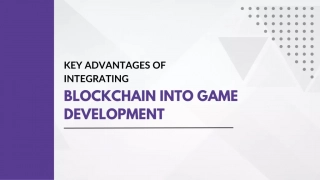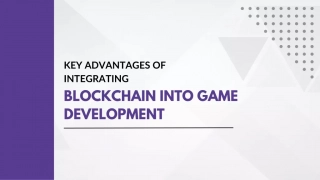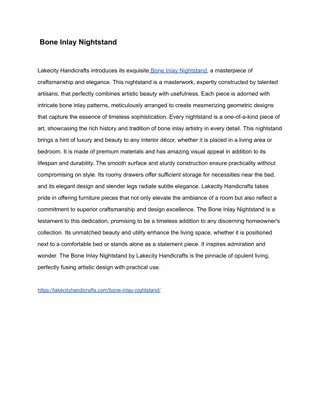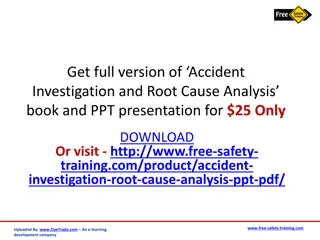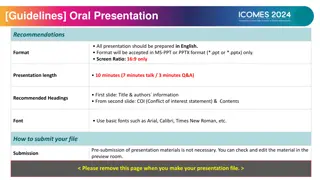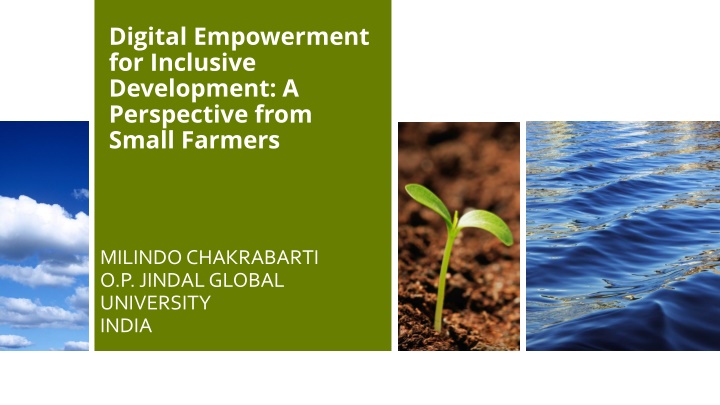
Digital Empowerment for Inclusive Development: Small Farmers Perspective
Explore the global status of small farmers, highlighting the challenges they face including undernourishment and food insecurity. Learn about the vital role of agriculture in poverty reduction and the urgent need for support to address the risks and responsibilities small farmers endure daily, especially in the face of climate change. Discover how digitalization of farming systems could bridge the digital divide and provide essential assistance to small farmers.
Download Presentation

Please find below an Image/Link to download the presentation.
The content on the website is provided AS IS for your information and personal use only. It may not be sold, licensed, or shared on other websites without obtaining consent from the author. If you encounter any issues during the download, it is possible that the publisher has removed the file from their server.
You are allowed to download the files provided on this website for personal or commercial use, subject to the condition that they are used lawfully. All files are the property of their respective owners.
The content on the website is provided AS IS for your information and personal use only. It may not be sold, licensed, or shared on other websites without obtaining consent from the author.
E N D
Presentation Transcript
Digital Empowerment for Inclusive Development: A Perspective from Small Farmers MILINDO CHAKRABARTI O.P. JINDAL GLOBAL UNIVERSITY INDIA
THE GLOBAL STATUS OF SMALL FARMERS 72% of the global farms are smaller than one hectare in size; 12% are 1 2 ha in size; and 10% are between 2 and 5 ha. Only 6% of the world's farms are larger than 5 ha. (Lowder et al 2021)
THE GLOBAL STATUS OF SMALL FARMERS Prevalence of undernourishment started increasing from 2017 (7.6%) and reached 9.8% in 2021 (FAOSTAT). 11.7% of global population suffered from severe food insecurity in 2021 compared to 7.7% in 2014 (FAOSTAT).
THE GLOBAL STATUS OF SMALL FARMERS Small farms still produce roughly 35 percent of the world's food (Lowder et al 2021, FAO). Today, more than 800 million people across the globe go to bed hungry every night, most of them smallholder farmers who depend on agriculture to make a living and feed their families (USAID).
THE IMMEDIATE NECESSITY Growth in the agriculture sector -- from farm to fork -- has been shown to be at least twice as effective in reducing poverty as growth in other sectors (USAID).
THE IMMEDIATE NECESSITY The risk and responsibility these farmers face on a daily basis is not matched by the financial, institutional, technical and technological support they need to thrive (WEF). It can be argued that food insecurity cannot be tackled if these supports are not provided.
THE IMMEDIATE NECESSITY Climate change is an added complication faced by them. It can affect crops, livestock, soil and water resources, rural communities, and agricultural workers. However, the agriculture sector also emits greenhouse gases into the atmosphere that contribute to climate change (USEPA).
LOOKING FOR DIGITALIZATION Digitalization of farming system may provide the necessary support if it can take care of the emerging digital divide.
ADDRESSING DIGITAL DIVIDE Farm planning Land title Access to advisory services Risk management Access to credit Access to market (Marie 2023)
ADDRESSING DIGITAL DIVIDE They are to be taken care of not in silos but in a collective manner Digitalization would require to combine all of these features in a single format, that would help understand the interlinkages among the issues
A POSSIBLE SOLUTION Can not be done privately by individual small farmers. Would require public investment to create global public good accessible to all. All contribute, all benefit and all decide argument for co-creation
THANK YOU!!!



